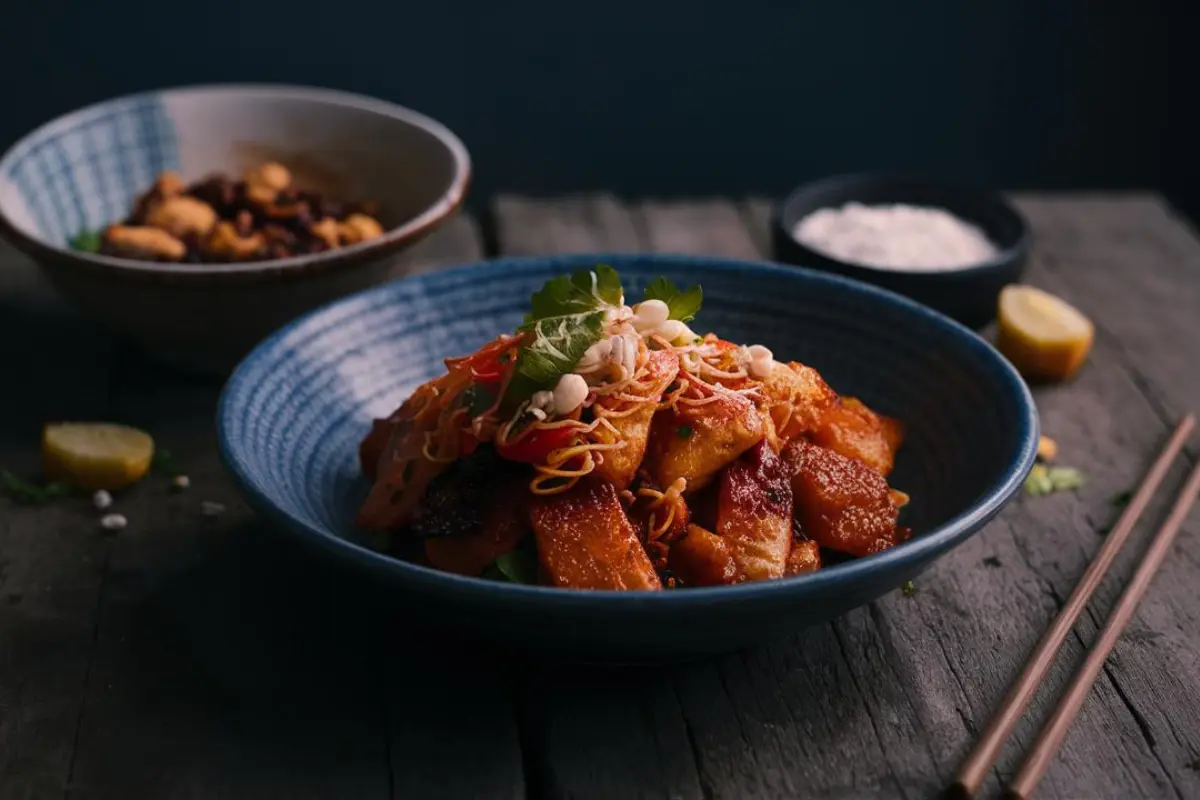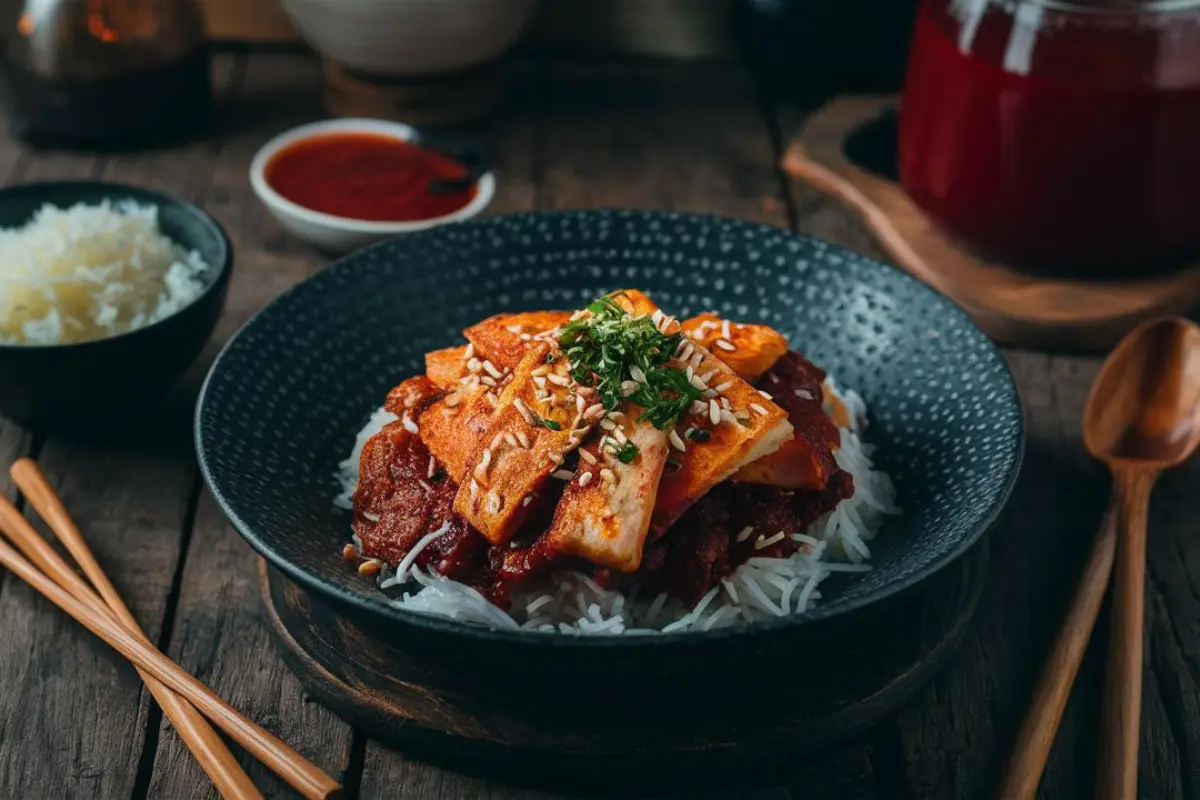Tteokbokki (떡볶이) is one of South Korea’s most beloved street foods, often found in bustling markets, food stalls, and even in fine dining restaurants. This dish primarily consists of soft, chewy rice cakes called tteok and a spicy, savory sauce made with gochujang (Korean red chili paste). It is a comfort food for many Koreans and has gained international recognition for its unique taste and texture.
Historical Background of Tteokbokki
Tteokbokki has a rich history that dates back to the Joseon Dynasty (1392–1897). Originally, it was a royal dish known as gungjung tteokbokki, which was stir-fried with soy sauce instead of the spicy gochujang that we know today. The modern version, which is spicy and vibrant, became popular in the 1950s and has since evolved into various forms, adapting to modern tastes while maintaining its traditional roots.
Ingredients of Tteokbokki
The Core Ingredients: Rice Cakes and Gochujang
The essence of Tteokbokki lies in two main ingredients:
- Rice Cakes (Tteok): These cylindrical rice cakes are made from glutinous rice flour, giving them a distinctively chewy texture. They are often sold in cylindrical shapes, but other shapes like flat discs or tubes can also be used.
- Gochujang: This fermented red chili paste is the heart of the Tteokbokki sauce. It’s made from chili powder, glutinous rice, fermented soybeans, and salt, providing a deep, rich flavor that balances spiciness with sweetness.
Common Additions to Tteokbokki
While the basic recipe for Tteokbokki includes just rice cakes and sauce, numerous variations incorporate additional ingredients such as:
- Fish Cakes (Eomuk): Thin, flat fish cakes are a popular addition, adding a savory, umami flavor.
- Boiled Eggs: Often served halved, boiled eggs absorb the sauce, providing a creamy contrast to the chewy rice cakes.
- Vegetables: Cabbage, carrots, and green onions are commonly added to enhance the dish’s texture and nutritional value.
- Cheese: Melting cheese over Tteokbokki has become increasingly popular, especially among younger generations, for its creamy and indulgent.
What does tteokbokki taste like
The Flavor Profile of Tteokbokki
The Sweetness in Tteokbokki
One of the most notable aspects of Tteokbokki is its balanced flavor profile, where sweetness plays a significant role. The gochujang provides a natural sweetness that is complemented by the addition of sugar or corn syrup in many recipes. This sweetness balances the heat from the chili paste, making the dish more palatable for those who may be sensitive to spice.
The Spiciness of Tteokbokki
Tteokbokki is renowned for its spiciness, a characteristic that defines the dish. The heat level can vary depending on the amount of gochujang used and the addition of other spicy ingredients like red pepper flakes or fresh chili peppers. This spice provides a warming sensation that builds up gradually, making each bite more intense than the last.
The Umami Element
Umami, the fifth, is deeply present in Tteokbokki, largely due to the gochujang and the inclusion of fish cakes or other seafood-based ingredients. This savory depth enhances the overall flavor, making the dish more satisfying and complex.
The Chewy Texture of Rice Cakes
Perhaps the most distinctive feature of Tteokbokki is the texture of the rice cakes. They are soft yet chewy, providing a delightful contrast to the smooth and thick sauce. This chewiness is a signature of the dish, offering a satisfying mouthfeel that is both comforting and addictive.
Variations of Tteokbokki
Classic Tteokbokki
The classic version of Tteokbokki features the core ingredients of rice cakes, gochujang sauce, and often fish cakes. It is the most traditional form and is widely available across Korea, from street vendors to home kitchens.
Creamy Tteokbokki
Creamy Tteokbokki introduces dairy into the mix, usually in the form of cream or milk, to create a richer, smoother sauce. This version is less spicy than the classic and has a mild, comforting flavor that appeals to those who prefer a less intense heat.
Cheese Tteokbokki
Cheese Tteokbokki is a modern twist on the classic dish, where shredded cheese is melted over the top, creating a gooey, indulgent layer that enhances the texture and flavor. The creaminess of the cheese contrasts with the spicy sauce, creating a balanced dish that is particularly popular among younger generations.
Rose Tteokbokki
Rose Tteokbokki is a fusion version that combines the traditional spicy sauce with a creamy tomato-based sauce, similar to a pasta sauce. The result is a dish that has both the heat of Tteokbokki and the comforting creaminess of a tomato sauce, creating a unique flavor profile.
Jjajang Tteokbokki
Jjajang Tteokbokki is a variation that incorporates jjajang sauce, a black bean paste sauce used in Korean-Chinese cuisine. This version is less spicy and has a deep, savory flavor, with a slightly sweet and earthy taste from the black bean paste.
What does tteokbokki taste like
The Experience of Eating Tteokbokki
Tteokbokki as a Street Food Experience
Tteokbokki is often associated with street food culture in Korea. The experience of eating Tteokbokki from a food stall, with the aroma of the sauce wafting through the air, is a cherished memory for many. The communal aspect of enjoying Tteokbokki with friends or strangers at a crowded stall adds to the dish’s appeal.
Tteokbokki in Restaurants and Home Kitchens
While Tteokbokki is widely available as street food, it is also commonly prepared at home or served in restaurants. In restaurants, Tteokbokki might be served as part of a larger meal, accompanied by side dishes and drinks. At home, it’s a quick and easy dish that families often make together, tailoring the ingredients and spice level to their preferences.
What does tteokbokki taste like
Pairing Tteokbokki with Other Dishes
Tteokbokki and Fish Cakes
Fish cakes, or eomuk, are a classic companion to Tteokbokki. They absorb the sauce well, adding an extra layer of flavor and a different texture that complements the chewiness of the rice cakes.
Tteokbokki with Ramyeon (Korean Instant Noodles)
A popular combination is adding ramyeon to Tteokbokki, creating a heartier dish. The noodles soak up the sauce, making each bite rich and flavorful. This combination is particularly satisfying for those looking for a more filling meal.
Tteokbokki and Fried Foods
Pairing Tteokbokki with fried foods like tempura or fried chicken is another common practice. The crispiness of the fried items contrasts with the chewy rice cakes and the spicy sauce, creating a delightful balance of textures and flavors.
Cultural Significance of Tteokbokki
Tteokbokki in Korean Pop Culture
Tteokbokki is not just a dish; it’s a cultural icon in Korea. It frequently appears in Korean dramas and movies, often depicted as a beloved comfort food. Its popularity has made it a symbol of Korean street food culture, and it’s celebrated in festivals and food events across the country. What does tteokbokki taste like
Tteokbokki in Social Gatherings
Tteokbokki is a popular choice for social gatherings, whether it’s a casual hangout with friends or a family dinner. Its versatility makes it suitable for various occasions, and its communal nature—where everyone can dig into a shared pot—makes it perfect for bringing people together.
Nutritional Profile of Tteokbokki
Tteokbokki is a carb-heavy dish, primarily due to the rice cakes. A typical serving provides a significant amount of calories from carbohydrates, with moderate amounts of protein and fat, especially when fish cakes and eggs are added. The gochujang sauce adds some vitamins and minerals, particularly from the chili peppers.
How to Make Tteokbokki at Home
Essential Tools and Ingredients
To make Tteokbokki at home, you’ll need:
- Ingredients: Rice cakes, gochujang, fish cakes, sugar, soy sauce, garlic, green onions, and boiled eggs.
- Tools: A large pan or wok, a mixing spoon, and a pot for boiling the rice cakes.
Step-by-Step Recipe for Classic Tteokbokki
- Prepare the Ingredients: Soak the rice cakes in water if they’re hard. Slice the fish cakes and chop the vegetables.
- Make the Sauce: In a pan, combine gochujang, sugar, soy sauce, garlic, and water. Stir until well mixed.
- Cook the Rice Cakes: Add the rice cakes to the sauce and simmer on medium heat. Stir occasionally to prevent sticking.
- Add the Fish Cakes and Vegetables: After a few minutes, add the fish cakes and vegetables. Cook until everything is well-coated with the sauce and the rice cakes are soft and chewy.
- Serve and Enjoy: Garnish with green onions and boiled eggs. Serve hot.
What does tteokbokki taste like
Conclusion:
Tteokbokki is more than just a snack; it’s a culinary experience that offers a harmonious blend of flavors and textures. Whether you’re enjoying it on the streets of Seoul or making it in your kitchen, the appeal of Tteokbokki lies in its ability to be both comforting and exciting. Its unique combination of sweet, spicy, and umami flavors, paired with the chewy texture of the rice cakes, makes it a dish that’s hard to resist. What does tteokbokki taste like
Frequently Asked Questions
Is Tteokbokki very spicy?
Tteokbokki is traditionally quite spicy, but the heat level can be adjusted depending on the amount of gochujang used. Some variations are milder, like creamy or rose Tteokbokki.
What are the main ingredients in Tteokbokki?
The main ingredients in Tteokbokki are rice cakes (tteok), gochujang (Korean chili paste), and fish cakes (eomuk). Additional ingredients often include vegetables, boiled eggs, and sometimes cheese.
How do you make Tteokbokki less spicy?
To make Tteokbokki less spicy, you can reduce the amount of gochujang or add more sugar or cream to balance out the heat. Alternatively, using a mild chili paste can also help.
Can Tteokbokki be eaten cold?
While Tteokbokki is traditionally served hot, it can be eaten cold, though the texture of the rice cakes becomes firmer and less chewy as it cools.
What can you add to Tteokbokki to make it more filling?
To make Tteokbokki more filling, you can add ingredients like ramyeon (instant noodles), dumplings, or extra vegetables. Adding protein-rich ingredients like boiled eggs or tofu can also enhance the dish’s satiety.
What does tteokbokki taste like?



